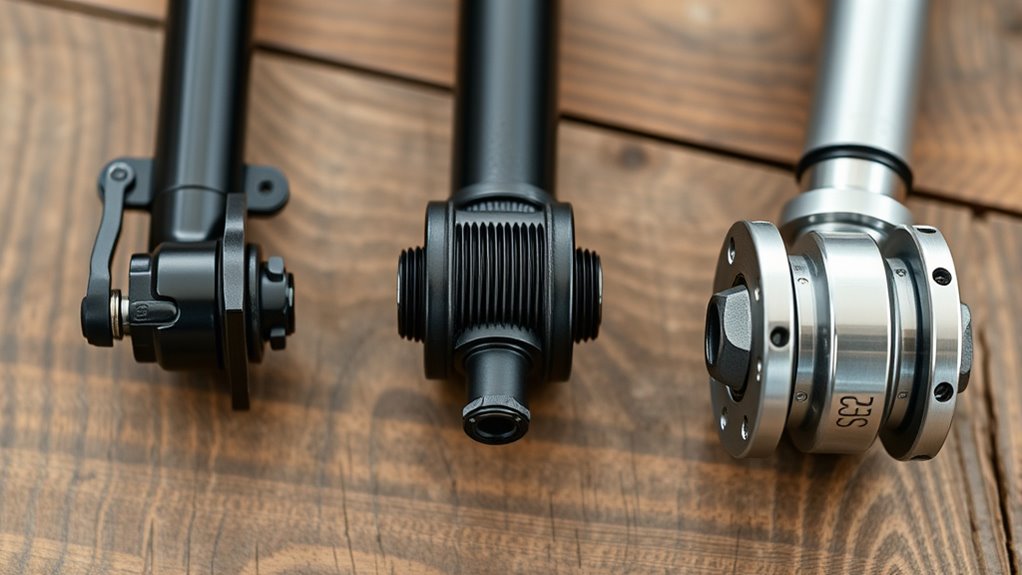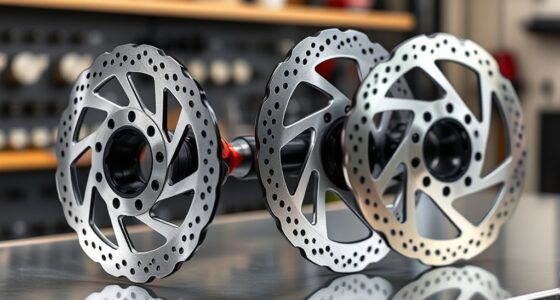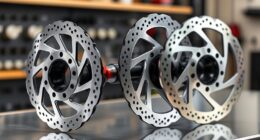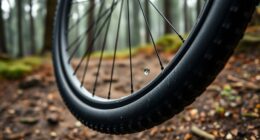Axle standards like QR, thru-axle, and boost guarantee your wheels fit securely and perform reliably. QR axles are quick to remove, ideal for casual riding, while thru-axles thread directly into hubs for increased stiffness, important for performance bikes. Boost standards widen hub spacing for better strength and handling. Staying aware of these standards helps you choose compatible components, and there’s more to uncover if you keep exploring how these systems work together.
Key Takeaways
- QR (Quick Release) axles enable fast wheel removal, using a lever mechanism without threading into the hub.
- Thru-axles thread directly into the hub, providing increased stiffness, security, and compatibility with modern bike standards.
- Boost standards feature wider hub spacing (e.g., 110mm, 148mm) for improved strength, handling, and wheel stability.
- Axle diameters vary (12mm, 15mm, 20mm), with standards ensuring compatibility across different bikes and components.
- Manufacturing guidelines specify materials and dimensions to guarantee safety, durability, and seamless fit for QR, thru-axle, and Boost systems.

Have you ever wondered how different vehicles and machinery guarantee their axles are safe and compatible? It all comes down to strict standards and precise specifications that manufacturers follow. One of the key aspects in ensuring compatibility and safety is understanding hub spacing. Hub spacing refers to the distance between the centers of the hub flanges where the wheel attaches. This measurement varies depending on the type of vehicle or machinery, and getting it right is crucial for proper fit and handling. If the hub spacing isn’t correct, wheels may not align properly, leading to issues like uneven wear, compromised safety, or even failure during operation. When selecting axles, you need to consider the hub spacing to ensure the axle matches the wheel setup. Different standards exist for various applications, such as bicycles, motorcycles, cars, or industrial machinery, each with specific hub spacing requirements. Alongside hub spacing, axle material plays a vital role in determining durability and performance. Common materials include steel, aluminum, and composites, each with its advantages. Steel, for example, offers high strength and resilience, making it suitable for heavy-duty applications. Aluminum is lighter, which benefits vehicles where reducing weight is essential, like racing bikes or performance cars. The choice of axle material influences how well the axle withstands forces, vibrations, and environmental factors. Manufacturers adhere to standards that specify acceptable materials and manufacturing processes to guarantee longevity and safety.
When it comes to newer axle standards such as QR (Quick Release), Thru-axle, and Boost, the focus shifts toward compatibility with modern bike components and improved ride quality. QR axles are designed for quick wheel removal, mainly used on traditional bicycles. They rely on a skewer that clamps the wheel to the fork or frame, and standards specify their diameter and length to ensure they fit correctly. Thru-axles are more robust, threading directly into the hub and providing increased stiffness and security, especially important for mountain biking or heavy-duty use. They have precise diameter standards, often 12mm, 15mm, or 20mm, depending on the application. Boost standards, on the other hand, refer to wider hub spacing—such as 110mm or 148mm—allowing for stronger wheels and better handling. These standards ensure compatibility across different brands and models, preventing issues like incompatible hubs or improper wheel fit. Manufacturers follow strict guidelines for hub spacing, axle diameter, and material specifications to guarantee that these components work seamlessly together.
Frequently Asked Questions
How Do I Measure My Axle Length Accurately?
To measure your axle length accurately, you need to use a ruler or caliper for precise measurements. First, remove the axle from your bike. Place the tool across the ends of the axle, measuring from one end to the other. Make sure to account for any threads or end caps. Proper tool selection guarantees accuracy, especially if your axle has unique features, so choose a caliper or ruler suited for small measurements.
Are QR Axles Compatible With Thru-Axle Frames?
You might wonder if QR axles fit thru-axle frames, and the answer isn’t straightforward. Quick release axles aren’t universally compatible with thru-axle frames, especially when considering axle length measurement, brake compatibility, and upgrade options. To guarantee a perfect fit, check your bike’s specifications. If you’re eyeing an upgrade, knowing these details helps you select the right axle type, avoiding surprises during your ride.
What Is the Impact of Axle Standards on Wheel Resale Value?
Your choice of axle standards can profoundly impact your wheel resale value. If you opt for widely compatible standards like thru-axle or Boost, your wheels become more appealing to a broader audience, boosting resale potential. Conversely, wheels with specialized or outdated standards might face limited buyer interest, reducing their resale value. Ensuring good wheel compatibility with current standards helps you get the best return when you sell.
Can I Upgrade My Bike to a Different Axle Standard?
Like changing the tune of a familiar song, upgrading your bike’s axle standard is possible but tricky. You can perform an axle conversion, but compatibility issues often arise, requiring new hubs, wheels, or adapters. Before proceeding, check your frame and fork specs carefully. If you ignore these details, you risk ending up with a mismatched setup that won’t fit or function properly, turning your upgrade into a frustrating detour.
Do Boost Axles Affect Brake Compatibility?
Yes, boost axles can affect brake compatibility. When upgrading to boost spacing, you might need to adjust your brake calipers to accommodate the wider hub width, ensuring proper alignment. Check if your wheel compatibility supports boost spacing and verify if your brake calipers can be adjusted or require replacement. Proper adjustments keep your braking performance reliable and safe, preventing rubbing or misalignment issues.
Conclusion
Understanding axle standards like QR, thru-axle, and boost helps you choose the right setup for your bike. Did you know that over 60% of new mountain bikes now use boost spacing? Staying informed guarantees your components are compatible and your ride stays smooth. So, next time you’re upgrading or replacing parts, remember these standards—your bike’s performance depends on it. Keep riding confidently with the right axle choice!








